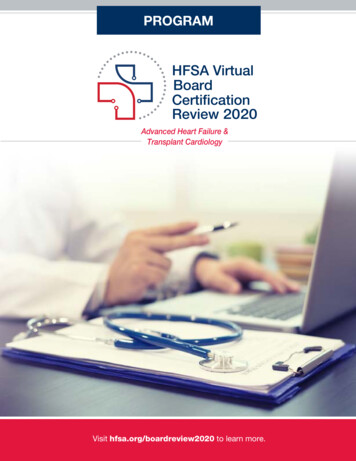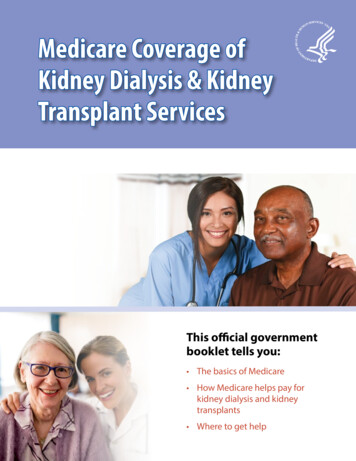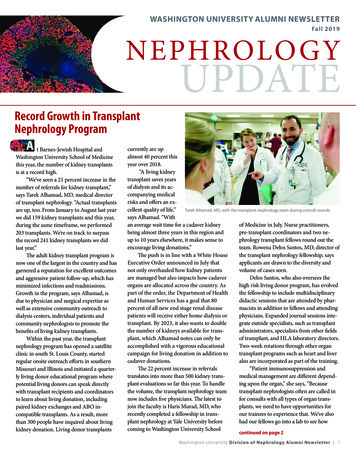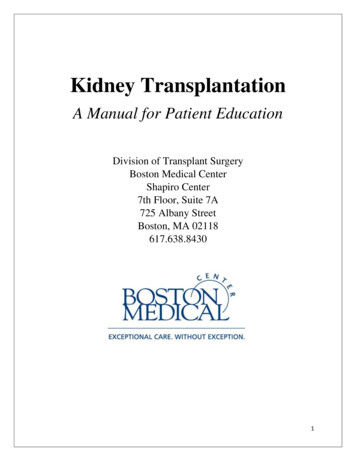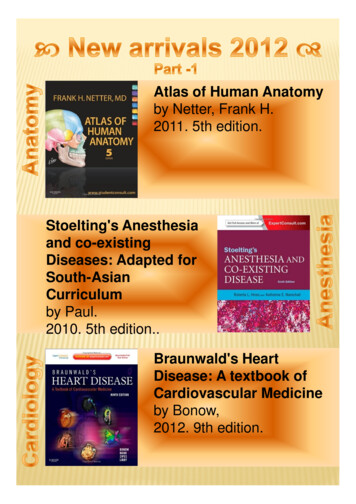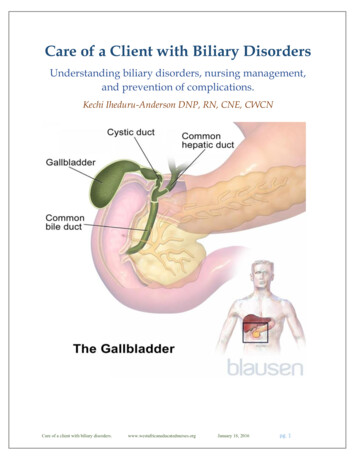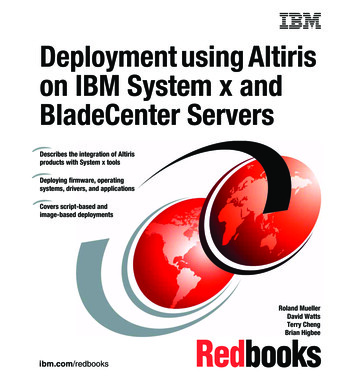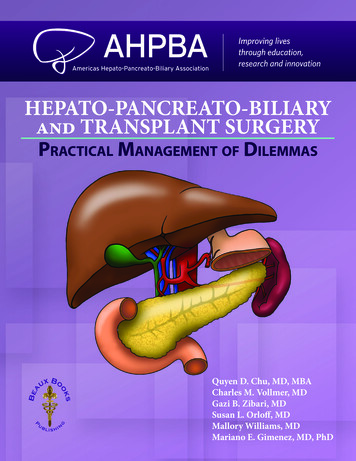
Transcription
HEPATO-PANCREATO-BILIARYand TRANSPLANT SURGERYPractical Management of DilemmasQuyen D. Chu, MD, MBACharles M. Vollmer, MDGazi B. Zibari, MDSusan L. Orloff, MDMallory Williams, MDMariano E. Gimenez, MD, PhD
Forty years ago, well within the lifetime of most of us, the practice of hepatopancreatobiliary surgery barely existed. Whilethere was great interest and research in HPB pathophysiology,therapeutic options were limited, and operative interventions,in particular, remained rare. Attempted operations were typically high-risk, resource-intensive procedures associated withhigh morbidity and mortality, undertaken only by the boldest ofsurgeons. Over the ensuing several years, however, the work ofmany pioneering investigators set the stage for the emergence ofHPB as a specialty area of surgery in its own right, bringing it outof the dark ages and into the mainstream of practice. Indeed, inthe current state of the art, HPB operations are now commonplace for a wide array of disease processes, with the expectationof successful outcomes for most patients.Many factors have played a role in the remarkable transformation of the field, too many to list here,but the point is that our surgical forebears laid a solid foundation upon which the technical advances thathave shaped our field have been built. As the beneficiaries of these advances and hard-won lessons from thepast, we now have the ability to offer effective and safe surgical therapies to our patients. But for those towhom much has been given, much is expected, and it is our charge now to continue refining and improvingthe clinical, technical, and investigative aspects of HPB surgery, to work toward uniform standards of trainingand practice, and to continually assess and reassess the long-term results of our interventions. It is imperativethat we do this, first and foremost, to ensure the best possible outcomes for our patients, and also to honor thelegacy of those great surgeons and others who have blazed the trail that we all now have the privelege to hike.It is also fitting and proper for the AHPBA to be a leader in this process. Formally established in1994 as the American Chapter of the IHPBA, the society has grown from a small group of surgeon thoughtleaders to a powerful, well-funded, and dynamic society of over 1500 members. Over the years, this chapterhas evolved to become renamed the Americas, proudly claiming members from the northern reaches ofCanada to the southernmost regions of South America, and every country in between. The AHPBA is nowone of the largest and most active societies dedicated to advancing the field of HPB surgery by disseminatingknowledge, fostering research and innovation, advancing education and training, and encouraging multidisciplinary collaboration.The current textbook was undertaken by the AHPBA leadership in an ongoing effort to fulfill itsmission. Written in a novel, dilemma-focused format, with each chapter addressing a specific question, thisis a unique textbook addressing all aspects of HPB surgery by society members who are leading experts inthe field. The book is well illustrated, with several salient points highlighted at the end of each chapter. Thescope of the book is very broad, and its content is thus appropriate for a wide range of readers, from residentsand fellows to established general surgeons and expert HPB surgeons. We expect that this text will remain animportant resource for many years to come.FOREWORDFOREWORD
FOREWORDFOREWORDIt has been a privilege for us to have played a small part in this project and in the ongoing advancement of the field through the AHPBA. We congratulate the book’s editors, the contributing authors, theAHPBA leadership, and Marjorie Malia and the staff at Association Management for the great effort in bringing this book to completion.William R. Jarnagin, MDNew York, NYWilliam C. Chapman, MDSt. Louis, MO
PREFACESurgical management of diseases affecting the liver, pancreas, and biliary tract (HPB) is a mature but rapidly evolving discipline. Clinicians with special interest in these 3 organ systems have diligently endeavoredthrough the decades to innovate their specialties to first and foremost optimize patient outcomes. With asteadfast commitment to this principle, these clinicians have created thriving societies such as the AmericasHepato-Pancreato-Biliary Association (AHPBA) and the International Hepato-Pancreato-Biliary Association (IHPBA). The former has over 1,200 active members from over 40 countries throughout North, Central,and South America, while the latter includes over 1,800 members from over 60 different countries.In 2017, the AHPBA leadership set out to publish a practical textbook, with chapters written by theexperts in the field that would encompass a broad range of HPB topics, with the intention of dispersing critical knowledge towards the mission of educating practicing surgeons, physicians, and the wider health careprovider community. The goal was to encapsulate the essence of this vibrant and exciting discipline in a morecogent, concise, and practical manner than traditional texts. We editors hope that this textbook, HepatoPancreato-Biliary and Transplant Surgery: Practical Management of Dilemmas, has achieved its goals.The editors aimed to develop a format of the HPB textbook that encompasses a broad clinical scopeof 5 disciplines: surgical oncology, HPB surgery, transplantation, interventional radiology, and trauma. Thecontent of Hepato-Pancreato-Biliary and Transplant Surgery: Practical Management of Dilemmas is furtherdivided into 6 major sections: (1) Hepatic, (2) Biliary, (3) Pancreatic (4) Transplantation, (5) Trauma, and (6)Innovation and Technology.We believe that one of the unique aspects of Hepato-Pancreato-Biliary and Transplant Surgery:Practical Management of Dilemmas is its format. Rather than assigning a chapter a traditional title suchas “Gallstone Ileus,” the title is presented in the form of a question, such as “Should a Cholecystectomy BeDone for Gallstone Ileus?” This approach reflects the mindset of a clinician who is facing an actual clinicaldilemma and wants to know how to best care for his/her patient. Another distinct feature of this textbookis that each section is structured into 3 major components (preoperative, intraoperative, and postoperative)that highlight dilemmas across the spectrum of care. Furthermore, embedded within each of these components are debates that we believe provide a wonderful opportunity for the readers to have a more in-depthunderstanding of simmering controversies in HPB diseases.Hepato-Pancreato-Biliary and Transplant Surgery: Practical Management of Dilemmas has been aglobal undertaking. Over 350 authors from different corners of the globe have contributed to its final product. Each chapter is written by recognized experts and begins with a clinical scenario followed by a conciseand in-depth text that is filled with compelling images, detailed illustrations, comprehensive tables, thoroughalgorithms, and other adjunctive tools that enhance the learning process. Key references are provided forfurther review. The ‘”Salient Points” at the end of each chapter reinforce key concepts for the readers.We have strived to address a broad spectrum of clinically relevant scenarios in this large- volume textbook, with the understanding that additional content may have been omitted due to text length and contentevolution constraints. Hence, we welcome suggestions from you, the readers, with the prospect that we willP R E FAC EPREFACE
P R E FAC EPREFACEPREFACEincorporate your valuable suggestions into future editions.We hope that you will benefit from and enjoy this textbook, and believe that you will find HepatoPancreato-Biliary and Transplant Surgery: Practical Management of Dilemmas to be not only an invaluableresource, but also a must-have textbook for all interested in this exciting specialty.Quyen D. Chu, MD, MBACharles M. Vollmer, MDGazi B. Zibari, MDSusan Orloff, MDMallory Williams, MDMariano Gimenez, MD, PhD
H E PAT I C3CHAPTERIs There a Role for LivingDonor Liver Transplant forHepatocellular Carcinoma?Khalid Khwaja, MD, and Robert A. Fisher, MDCase ScenarioA 52-year-old Caucasian man with HCV cirrhosis, genotype 1a, treatment-naïve, presented with a 7.2 cm enhancinglesion in segment 6 of his liver, consistent with hepatocellular carcinoma (Figure 1). He had grade 1 esophageal varicesand a history of encephalopathy. His total bilirubin was 2.1 mg/dl, creatinine 1.3 mg/dl and INR 1.6, giving him a calculated MELD score of 16. His platelet count was 63,000/µL, albumin 2.1 g/dl and alpha-fetoprotein 78 ng/ml. Givenhis advanced liver disease, he was not felt to be a candidate for surgical resection. He did not qualify for exceptionMELD points for transplant, as his tumor was 5cm.On further work-up, there was no evidence of extra-hepatic disease and he had no significant comorbid condition.The primary lesion was targeted with trans-arterial Yttrium90 embolization after appropriate planning studies. Threemonths after the procedure, the tumor had decreased to 4.8cm with central necrosis and a small rim of peripheralenhancement (Figure 2). His total bilirubin remained stable at 2.2 mg/dl and alpha-fetoprotein decreased to 34 ng/ml.At 6 months post-embolization, there was no clinical or radiological progression of disease. His brother had beenevaluated and approved as a living liver donor. He underwent an uneventful living donor liver transplant, receiving aright lobe graft. Anterior sector venous outflow was established using deceased donor aortic conduit to reconstructsegment 5 and 8 hepatic veins, and a duct to duct biliary anastomosis was performed (Figures 3-6).At 2 years post-transplant, he received ledipasvir/sofosbovir treatment for HCV with a sustained viral response at12 weeks. At 5 years post-transplant, he is alive with no evidence of tumor recurrence.BackgroundLiver transplantation for cirrhotics with unresectable hepatocellular carcinoma (HCC) has been an accepted treatment forover two decades. Outcomes are excellent in recipients withStage 1 (single lesion 2cm) or Stage 2 (single lesion 2-5cmor up to 3 lesions all 3cm) disease. Equivalent survival hasalso been achieved in individuals with more extensive diseaseapplying the so-called ‘expanded-criteria.’ In the US, patientswith Stage 2 HCC are prioritized for transplant by awarding‘exception’ MELD (Model for End Stage Liver Disease) pointsequivalent to a 15% 3 month mortality risk, and points areincreased every 3 months equivalent to a 10% 3 month mortality. However, there is much regional variation in the US as tohow long candidates wait to receive a transplant. In our region,wait times can be up to 18 months for candidates with HCC.Candidates who have higher than stage 2 disease, or ‘beyondMilan criteria’, received no exception points for transplantationand as such, living donor liver transplantation (LD LT) is theirbest hope of receiving a transplantEarly experience in the US suggested the rates of HCCrecurrence were higher after LDLT than after deceased donortransplant. This was likely due to more advanced disease aswell as a shorter interval to transplant in the LDLT group, thusselecting patients with biologically more aggressive disease.We believe that carefully selected candidates who are beyondMilan criteria for transplant can be successfully downstagedand receive liver transplants after an appropriate period ofobservation. There is currently no consensus as to what isappropriate for downstaging in terms of number and size oftumors. A conference in the US proposed a single tumor notgreater than 8 cm or up to three tumors, none greater than 5Chu Q, Vollmer C, Zibari G, Orloff S, Williams M, Gimenez M (eds).Hepato-Pancreato-Biliary and Transplant Surgery: Practical Management of Dilemmas
Living Donor Liver Transplantation for HCC19H E PAT I CFigure 1: A 7.2cm HCC in segment 6 of liver.Figure 2: Three months post Yttrium90 embolizationcm with a total tumor burden of less than or equal to 8 cm. TheKyoto group in Japan considers candidates for transplant withup to 10 tumors, all 5cm and others place no restriction ontumor number as long as none are 5cm.There is general consensus that there should be anappropriate waiting period between diagnosis and transplant.However, the optimal duration of this time period is less clear.We prefer to wait at least three months to allow a response todownstaging and to ascertain the true biology of the disease assupported by our past experience. Candidates with extrahepatic disease, single tumors 8cm, more than 3 tumors, macrovascular invasion, and alpha-fetoprotein levels 400 ng/mlare excluded. Less than a three month interval between tumorablation and transplantation and des-γ-carboxyl prothrombin(DCP) concentration 300 mAU /ml have also been shown tobe independent predictors of worse recurrence free survival.Many techniques are currently available and in use fortumor downstaging, including local ablation with radio frequency, microwave or percutaneous ethanol injection, or transarterial embolization with drug eluting beads or radiolabeledmicrospheres. Our preferred approach for larger lesions, suchas in this case, is using yttrium90 radioembolization (Y90).There is level two evidence that Y90 may be superior to transarterial chemoembolization (TACE) with a higher likelihoodof downstaging to within stage two. Cross-sectional imaging isrepeated at 1 and 3 months post-embolization and candidatesare fully ‘restaged’ prior to being accepted as transplant candidates.A comprehensive living donor selection evaluation is performed, as has been previously described by us. The recipientoperation is always started first, in the event that there may beextrahepatic tumor precluding transplant. This avoids unnecessary donor surgery. After careful inspection for extrahepaticmalignancy, recipient hepatectomy is performed in the standard way, minimizing handling of the area of tumor. The retrohepatic vena cava is preserved and the recipient liver dissectedoff that structure to allow for ‘piggybacking’ of the new livergraft. Venovenous bypass may be used if necessary.On the donor side, the right lobe is procured. Care istaken not to devascularize the bile duct. We strive to preserveas much length as possible of the portal vein and right hepaticartery. We prefer to stay to the right of the middle hepatic vein,saving that structure for the donor, and reconstructing any significant narrowing of segment five or eight veins of the donatedliver on the back table. The right hepatic artery is not dissectedbehind or to the left of the bile duct to prevent biliary ischemia.The graft is flushed with University of Wisconsin solution viathe portal vein and hepatic artery (Figure 3). Our preference isto reconstruct the anterior sector veins using deceased-donoraortic conduit if available (Figure 4). We found that the aorticconduit is easy to sew to and does not compress like the vein.Implantation of the graft begins with anastomosing the donorright hepatic vein directly to the cava or widened orifice of therecipient right hepatic vein followed by portal vein anastomosisand reperfusion of the liver. The conduit draining the anteriorsector veins can then be implanted directly into the cava or theorifices of the recipient middle and left hepatic veins as is ourpractice. An end-to-end right hepatic artery to right hepaticartery anastomosis is then performed followed by a duct toduct biliary anastomosis whenever feasible (Figure 5). We haveemployed both cryopreserved IVC and aortic conduit for our
H E PAT I C20Khwaja and FisherFigure 3: Right Living Donor Graft. The stumps of the RightHepatic Vein, Right Portal Vein, Right Hepatic Artery, andRight Common Hepatic Duct are shown. Also depicted aretwo large anterior sector hepatic veins (segments 5 and 8).Figure 5: Implantation of Liver. Donor Right Hepatic Veinis drained into the widened orifice of the recipient RightHepatic Vein. Anterior sector veins are drained via the aorticconduit into the recipient Middle and Left Hepatic Veins.Figure 4: Backtable reconstruction of anterior sector hepaticveins using deceased donor aortic conduit.Figure 6: Backtable. Reconstruction of anterior sector veinswith deceased donor aortic conduit.
Living Donor Liver Transplantation for HCCH E PAT I Creconstruction and have not seen HCCrecurrence over a one year follow-up.In instances where the suprahepaticvein branches or retrohepatic vena cavaof the recipient are compromised eitherbecause the HCC is very close to themor a reaction to Y90 is so severe that itmakes anastomosing to these venousstructures unsafe, we proceed with stapling the suprahepatic vein branchesand retrohepatic cava and the diseasedliver and involved venous structures arethen removed en-bloc. Reconstructionof the venous outflow tracts can be doneusing either cryopreserved IVC (Figure7) or ABO compatible cadaveric thoracic aorta that was saved from previousdonor procurement procedures (Figure8). The cryopreserved IVC is obtainedfrom LifeNet Health Transplant Services Division, a federally designatedOrgan Procurement Organization thatcoordinates the recovery and transplantof organs in Virginia and part of WestVirginia.We switch to mTOR- based immunosuppression whenever possible ataround three months using either everolimus or sirolimus for its theoreticalantitumor properties. Careful screeningfor HCC recurrence with cross-sectionalimaging is performed every threemonths for the first year post transplantand then less frequently subsequently.Screening should be continued for atleast five years post-transplant.22Figure 7: This is a depiction of a cryopreserved ABO matched IVC used to sew to therecipient IVC at the level of the right renal vein.Figure 8: ABO matched cadaveric thoracic aorta conduit was used to reconstructthe middle and right hepatic veins tract as a single outflow conduit, which is thenreanastomosed in a triangulated side to side fashion to the recipient’s IVC
Living Donor Liver Transplantation for HCC1.2.3.4.5.6.7.8.9.Yao FY. Expanded criteria for liver transplantation inpatients with hepatocellular carcinoma. Hepatol Res.2007; 37 Suppl 2:S267-74.Fisher RA, Kulik LM, Freise CE, Lok AS, Shearon TH,Brown RS Jr et al. Hepatocellular carcinoma recurrenceand death following living and deceased donor liver transplantation . Am J Transplant. 2007; 7(6):1601-8.Pomfret EA, Washburn K, Wald C, Nalesnik MA, DouglasD, Russo M, et al. Report of a national conference on liverallocation in patients with hepatocellular carcinoma in theUnited States. Liver Transpl. 2010; 16(3):262-78.Fujiki M, Takada Y, Ogura Y, Oike F, Kaido T, TeramukaiS, et al. Significance of des-gamma-carboxy prothrombinin selection criteria for living donor liver transplantation for hepatocellular carcinoma. Am J Transplant.2009;9(10):2362-71.Soejima Y, Taketomi A, Yoshizumi T, Uchiyama H,Aishima S, Terashi T, et al. Extended indication for livingdonor liver transplantation in patients with hepatocellularcarcinoma . Transplantation. 2007;83(7):893-9.Ramanathan R, Sharma A, Lee DD, Behnke M, BornsteinK, Stravitz RT, et al. Multimodality therapy and livertransplantation for hepatocellular carcinoma: a 14-yearprospective analysis of outcomes.Transplantation. 2014;98(1):100-6.Harimoto N, Yoshida Y, Kurihara T, Takeishi K, Itoh S,Harada N, et al. Prognostic impact of des-γ-carboxylprothrombin in living-donor liver transplantationfor recurrent hepatocellular carcinoma. TransplantProc. 2015;47(3):703-4.Lewandowski RJ, Kulik LM, Riaz A, Senthilnathan S,Mulcahy MF, Ryu RK, et al. A comparative analysis oftransarterial downstaging for hepatocellular carcinoma:chemoembolization versus radioembolization. Am JTransplant. 2009; 9(8):1920-8.Fisher RA. Living donor liver transplantation: eliminating the wait for death in end-stage liver disease? Nat RevGastroenterol Hepatol. 2017; 14(6):373-382.Salient Points LDLT is an excellent option for candidates with HCCwho do not qualify for exception MELD points or livein regions where wait times for transplant are long. Candidates for transplant must be carefully selectedbased on tumor size, number and other factors such asmacrovascular invasion and serum AFP levels. Tumors can be downstaged using local ablative orembolic techniques. An observatory period of at least3 months is recommended prior to transplant. In appropriately-selected recipients, outcomes withLDLT for HCC are equivalent to those achieved withdeceased donor transplants.H E PAT I CSelected References23
48CHAPTERA Pancreatic Cancer At ThePortal Confluence Requires A VeinResection. How Do You ReconstructThe Vein – Primary Repair, VenousConduit, Synthetic Graft?Jordan Cloyd, MD, and Jeffrey E. Lee, MDCase ScenarioBackgroundPDAC is one of the leading causes of cancer-related mortalityin the United States, largely due to the fact that the majorityof patients have metastatic disease at the time of presentation.Survival rates are better in patients with localized disease amenable to surgical resection, especially when combined withmultimodality therapy. Historically, vascular involvement,whether diagnosed radiographically prior to surgery or atthe time of laparotomy, was considered a contraindication tosurgical resection. Therefore, patients with localized cancersand major vessel involvement were treated solely with chemotherapy and radiation. Since surgical resection is considerednecessary, though not necessarily sufficient, for curative intent,attempts to extend the criteria of resectability to patients withvascular involvement have long been of interest.The first large series of vascular resection at the time ofpancreatectomy was described by Fortner as he introduced theconcept of “regional pancreatectomy” in the 1970s. AlthoughFortner’s original description demonstrated the technical feasibility of venous and arterial resections with pancreatectomy,the procedure was not associated with improved oncologicaloutcomes and therefore was largely abandoned. Nevertheless,over the past several decades, developments in cross sectionalimaging, preoperative staging, vascular techniques, and multimodality therapy have led investigators to again consider themerits of vascular resection at the time of pancreatectomy. InFIGURE 1: Preoperative computed tomography of borderline resectable pancreatic ductal adenocarcinoma with 180 involvement of the superior mesenteric vein (SMV).In order to perform a meticulous dissection of the superior mesenteric artery (SMA), given its proximity to thetumor (T), the splenic vein (SV) is divided. The SMV-PV isreconstructed primarily and a splenorenal shunt is createdto prevent sinistral hypertension.Chu Q, Vollmer C, Zibari G, Orloff S, Williams M, Gimenez M (eds).Hepato-Pancreato-Biliary and Transplant Surgery: Practical Management of DilemmasPA N C R E A SA 65-year-old woman was found to have a borderline resectable pancreatic ductal adenocarcinoma (PDAC) with 180 involvement of the superior mesenteric vein (SMV) (Figure 1). She received 4 cycles of FOLFIRINOX followed by30gy of external beam chemoradiation. After completing preoperative therapy, the CA 19-9 had decreased from 670to 29 U/L and repeat imaging demonstrated stable disease. At the time of pancreatoduodenectomy (PD), the masswas encasing the portal vein (PV) and SMV at the portosplenic confluence. After an en-bloc resection of the tumor,together with the portosplenic confluence, the PV-SMV was repaired primarily in end-to-end fashion. In addition,given that the inferior mesenteric vein (IMV) entered the SMV rather than the splenic vein (SV), and therefore couldnot decompress the divided SV, a splenorenal shunt was constructed.
356Cloyd and LeeTABLE 1: Criteria Defining Resectability Status (Data derived from the National Comprehensive Cancer Network. NCCNGuidelines, version 2.2016, Pancreatic Adenocarcinoma).VesselsPotentially ResectableBorderline ResectableNo tumor contactBody and Tail: 180 solid tumor contactNo tumor contactHead/Uncinate: Solid tumor contact without extension to celiac axis or hepatic arterybifurcation allowing for safe andcomplete resection and reconstructionNo tumor contactHead/Uncinate: 180 solid tumor contact Presence of variant arterial anatomyand the presence and degree of tumorcontact should be noted if present asit may affect surgical planningHead/Uncinate Process: 180 solid tumor contact Solid tumor contact with the 1st jejunalSMA branchBody and Tail: 180 solid tumor contactNo tumor contact or 180 contact withoutvein contour irregularity Head/Uncinate Process: Unreconstructible SMV/PV due totumor involvement or occlusion (can bedue to tumor or bland thrombus) Contact with most proximal drainingjejunal branch into SMVBody and Tail: Unreconstructible SMV/PV due totumor involvement or occlusion (can bedue to tumor or bland thrombus)CACHAPA N C R E A SUnresectable*SMA SMV/PVIVC 180 solid tumor contact with theSMV or PV 180 contact with contour irregularity of the vein or thrombosis of thevein but with suitable vessel proximaland distal to the site of involvementallowing for safe and complete resection and vein reconstructionHead/Uncinate Process: 180 solid tumor contactBody and Tail: Solid tumor contact and aortic involvement 180 solid tumor contactSolid tumor contact* Distant metastasis is considered unresectable; CA: Celiac Artery; CHA: Common Hepatic Artery; SMA: Superior Mesenteric Artery; SMV: Superior Mesenteric Vein; PV: Portal Vein; IVC: Inferior Vena Cavafact, pancreatectomy with venous resection comprises a substantial proportion of operations for PDAC at high volumecenters and large series suggest no worse survival in patientsthat are able to undergo a margin negative resection.Patient SelectionSince microscopic and macroscopic resections are associatedwith both locoregional recurrence and reduced overall survival, the likelihood of obtaining a margin negative resectionmust be critically assessed when evaluating whether to proceedwith surgical resection. As the ability to safely perform complexvascular resections at the time of pancreatectomy has evolved,a new radiographic classification system was needed to moreaccurately characterize the anatomic relationship of the tumorto its nearby vascular structures. Broadly defined as potentiallyresectable, borderline resectable (BR) and locally advanced(LA) (Table), these designations provide important prognosticinformation regarding the ability to achieve a margin negativeresection, the likely need for vascular resection, and the selection of preoperative therapies prior to surgery.In addition to anatomic staging, patients must be appropriately selected in terms of their potential for harboring occultmetastatic disease as well as their physiologic capacity to safelyundergo major surgery. Patients with significantly elevatedCA 19-9, indeterminate liver or lung lesions, or subtle signs ofperitoneal disease should be considered for preoperative chemotherapy and/or chemoradiation therapy as an opportunityto select for patients with biologically favorable disease. Those
How to reconstruct the portal confluence when it is involved with pancreatic cancer357FIGURE 2: Schematic of the five forms of venous resection and reconstruction. PV: Portal Vein; SV: Splenic Vein; SMV:Superior Mesenteric Vein; IJ Graft: Internal Jugular Vein Graft (Adapted with permission from Springer in Tseng JF, RautCP, Lee JE, et al. Pancreaticoduodenectomy with vascular resection: margin status and survival duration. J GastrointestSurg 2004; 8(8):935–49).PA N C R E A Swho demonstrate normalization of their CA 19-9, as well asstable radiographic findings, could then be considered forsurgical resection. Similarly, those patients whose comorbidities or performance status make PD prohibitive should also beconsidered for preoperative therapy, simultaneously focusingon improving their suitability for surgery through medicaloptimization and prehabilitation.Surgical AnatomyVenous AnatomyThe pancreas is anatomically intimately associated with criticalvascular structures including the PV, SMV, celiac artery (CA),hepatic artery (HA) and superior mesenteric artery (SMA).The SMV drains the midgut and courses posterior to the neckof the pancreas, joining the splenic vein (SV) in order to formthe PV. The IMV typically drains into the SV but occasionallyenters in to the SMV or forms a common confluence with SMVand SV. The gastrocolic trunk is an early anterior tributary ofthe SMV and often divides into the right gastroepiploic andmiddle colic vein. The first jejunal vein typically runs posteriorto the SMA to join the ileal branch in order to form the SMV.The first jejunal vein carries particular significance as it can bedirectly invaded by tumors of the uncinate process, preventingseparation of the tumor from the SMV. In addition, injuries ofthe first jejunal vein can lead to excessive hemorrhage sincevascular control at the root of the mesentery can be extremelychallenging.Knowledge of the venous anatomy is critical to understanding and applying sound technical principles for venousreconstruction. In general, the limits of venous resectionextend proximally from the bifurcation of the left and right PVto the first jejunal/ileal branches in the root of the mesentery.The two most important factors to consider are the locationof the tumor relative to the portosplenic confluence and theextent of involvement. Classification systems exist that describethe extent of tumor involvement as a means of guiding thereconstruction (Figure 2).Arterial AnatomyThe SMA originates from the aorta and courses posterior to
358Cloyd and LeeFIGURE 4: Intraoperative photograft of SMV-PV reconstruction using internal jugular (IJ) vein as an interposition autograft. The graft is fashioned using interrupted6-0 Prolene a
We editors hope that this textbook, Hepato-Pancreato-Biliary and Transplant Surgery: Practical Management of Dilemmas, has achieved its goals. e editors aimed to develop a format of the HPB textbook that encompasses a broad clinical scope Th of 5 disciplines: surgical oncology, HPB surgery, t

